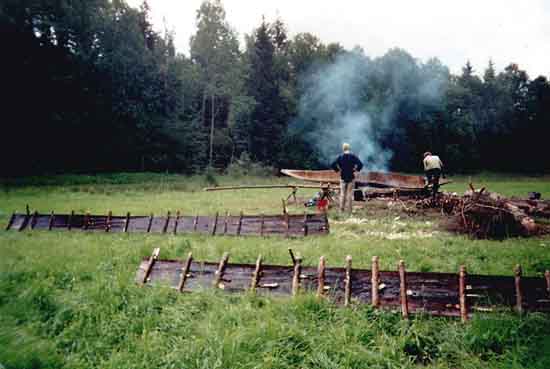Manufacturing of the planks
 Treatment of a plank piece over fire; it is getting flat all by itself,
without spreading bars.
Treatment of a plank piece over fire; it is getting flat all by itself,
without spreading bars.
|
Side strakes were also done with fire treatment, for experiment purpose. Pine log
was split by means of wedges into halves, which were then hollowed until they became
half-round in crossection with 12-13mm thick walls. They were flattened into planks
in the same way as bottom part was
expanded over fire. The technique was powerful enough to to turn 27cm diameter
pieces into completely flat planks without applying any external force, i.e. without using any
spreading bars or clamps. But tensions appeared to be too high,
and ready planks cracked too much when drying; still, they were used for the boat's strakes,
cracks stopped with melted spruce gum, bigger ones patched with
sewn lathes. Advantage of this technique is that planks become much wider then diameter
of trunk they were made of -- the trunk was from 35 (bottom) to 27(top) cm thick,
while ready planks width was from 47 to 35cm respectively. Total volume of wood reduced
into chips while making planks of a given width is about twice (that is, about
π2/4 times) less in comparison with ordinary technique, when trunk is split
into halves and two flat planks are carved out of them. So the technique with
expanding over fire can be less labour consuming, especially
when tools are small and light, and quality of steel and whetstones are low, as it was in
8th century. Original boat strakes, however, were not sufficiently preserved to
judge about the technique, but implementation of fire and steam is very doubtful in this
case.
 One can see ready planks left to dry, their wave-like crossection pattern clearly visible.
Planks are tied flat with a plenty of sticks, to prevent further waving and cracking.
One can see ready planks left to dry, their wave-like crossection pattern clearly visible.
Planks are tied flat with a plenty of sticks, to prevent further waving and cracking.
|
An interesting question is if planks were ever made this way; for example, in
Hjortspring boat, linden planks were so wide -- up to 80cm,
that
it appeared to be impossible to find trees of sufficient dimensions in whole northern Europe for
a replica building. At the same time planks were
incredibly thin -- only 1cm; these dimensions, (as well as the material -- linden,
which must have far higher cracking tension threshold then pine), match
the steam-and-fire expanding supposition very good, these planks could be
made of only 50cm thick trees, and if these trees were old and had rotten core, it could even make
the job easier.
 Treatment of a plank piece over fire; it is getting flat all by itself,
without spreading bars.
Treatment of a plank piece over fire; it is getting flat all by itself,
without spreading bars.
 Treatment of a plank piece over fire; it is getting flat all by itself,
without spreading bars.
Treatment of a plank piece over fire; it is getting flat all by itself,
without spreading bars.
 One can see ready planks left to dry, their wave-like crossection pattern clearly visible.
Planks are tied flat with a plenty of sticks, to prevent further waving and cracking.
One can see ready planks left to dry, their wave-like crossection pattern clearly visible.
Planks are tied flat with a plenty of sticks, to prevent further waving and cracking.